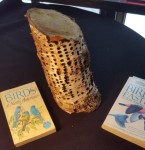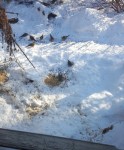
As most investigations do, this one began with a question. I had a log delivery to my house. The logs were primarily birch. What caused the damage to the birch trees that I was chopping up for wood? The holes were too shallow to suspect woodpeckers. I peeled off the bark, fully expecting to see insect galleries. There were none, but my internet search soon yielded pictures of similar damage caused by sapsuckers.
Some of my bird feeding stations have fat to attract woodpeckers. And so, I stood vigil to see if the fat might attract sapsuckers as well. Pictures from my reference book aided the identification.

Setting up a bird feeding station at school would be easy. The cost is minimal and there is no complicated storage. The seed could be stored in class in a steel trash bin. The lid should seal well to prevent attracting mice or other rodents.
Students could participate by taking turns filling the stations. Throwing in a few old logs and stumps would provide a natural setting. Identifying the birds and studying their ecological niche would be a great science activity. Students could also take part in the bird feeder surveys that are advertised from time to time.

Thanks for the submission Dave!
